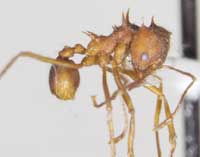 Characteristics:
Characteristics:
- Coloration: rust brown to dull dark brown
- Antennae have 11 segments but no easily defined club
- Vary greatly in size
- Workers are 1/6 to 1/2 inches long (polymorphic)
- Queen- 3/4inches long
- Workers have:
- Three pairs of prominent spines on the thorax
- One pair of spines on the back of the head
Colony reproduction takes place annually in mature colonies containing male and female reproductive forms. Winged females over an inch long, and winged males that are much smaller make massive mating flights on moonless nights in April and May, generally following rain. Virgin queens leave the parental nest with some of the colony fungus stored in the cavity in their mouthparts. This small amount of fungus will be used to start a new fungus garden after mating has occurred and a nesting site selected. The newly mated queen will excavate a shallow cavity in the soil, start a fungal garden and rear her first brood (eggs, larvae, and pupae) alone.
Emerging workers soon begin to forage for plant material that will provide a substrate on which to grow fungus for food. They prefer introduced cultivars to native plants. They select new leaves, flowers, and plant stems over mature ones, and prefer plant material with a high water content. The ants are very selective in their choice of plants to forage on and may travel great distances to collect specific plant materials.
The largest workers (soldiers) guard against intruders at nest entrances and patrol along the busy foraging trails protecting the medium-sized workers as they carry pieces of leaves they have cut and are in the process of transporting them back to the nest. Foraging workers carry their loads above their heads, at times resembling “parasols” and they are sometimes referred to as “parasol ants”. At the nest, smaller workers receive the leaf fragments and cut them into smaller pieces and pass them on to even smaller specialist ants that chew and macerate these leaf bits into a pulpy substrate. Tiny worker specialists introduce and cultivate a special fungus on this substrate that becomes the only food source for the entire colony. Worker specialists maintain these growing, expanding gardens and care for the queen and her brood that are kept here in fungal chambers. As the larvae emerge they feed on special structures called gongylidia and are cared for by special nurse ants. The adults also feed on gongylidia.
Distribution
Atta texana (Buckley) is a fungus ant commonly called the Texas leaf-cutter ant because it is found mainly in south central and eastern regions of the state. It also occurs in scattered locations in northwestern Louisiana. Primarily considered an agricultural pest, it has also been found in homes on occasions foraging on cereals. It is not a persistent invader of structures. It is estimated that this ant causes “agricultural” losses of $5 million annually in the United States. The Texas leaf-cutter colonies have a very complex social organization. Colonies typically have a single queen and a worker caste (sterile females) of many thousands of individuals, highly polymorphic, varying in size from 1/6 to 1/2 inches in length. The queen is huge, more than 1 inch long and can produce enormous egg masses that give rise to several million individuals. There is a high degree of task specialization among the workers. All colony members are rust-brown in color.
Nests of the leaf-cutter ant are established in open and brushy areas in deep, well-drained sandy or loamy soils. They may cover more than half an acre, marked by many crater-shaped mounds of loose soil, sloping inward to a center entry hole. Chambers containing fungus may be found at a depth of more than 8 feet. The nest is a complex structure designed to protect the colony and to provide a healthy, stable environment for the fungus gardens. Fresh air is drawn in through the peripheral tunnels to maintain proper ventilation throughout the nest. Stale air and heat produced by metabolic processes going on in the gardens is vented through central passageways above the gardens. Chambers within the nest are prevented from flooding by a system of lower passages. In hot, dry periods, nest openings are plugged and the workers retreat to more favorable moist areas below.
Management
Due to the large size and complexity of their nests it is difficult to obtain good control. There are no insecticides currently labeled for treating leaf-cutter ant nests. Treating these nests presents a danger of contaminating accessible water. The nest may be very deep and located near streams and rivers. Plants may be protected from these foraging ants by using labeled insecticide to treat plants for insect control. When foraging workers feed on the leaves of treated plants they will be killed or repelled.